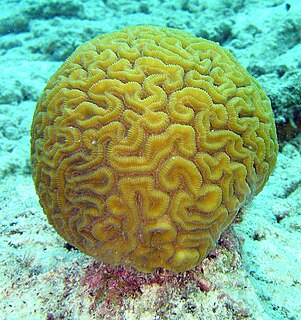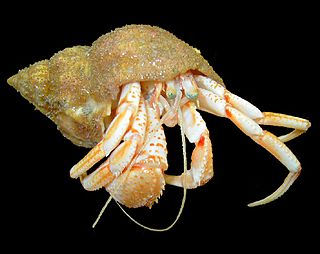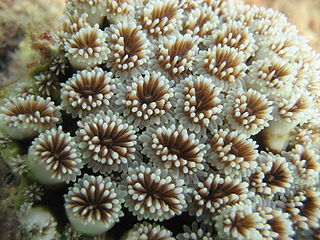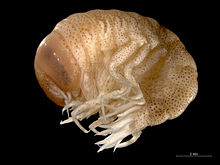
A fiddler crab, sometimes known as a calling crab, may be any of more than one hundred species of semiterrestrial marine crabs in the family Ocypodidae. A smaller number of ghost crab and mangrove crab species are also found in the family Ocypodidae. This entire group is composed of small crabs, the largest being slightly over two inches (5 cm) across. Fiddler crabs are found along sea beaches and brackish intertidal mud flats, lagoons and swamps. Fiddler crabs are most well known for their sexually dimorphic claws; the males' major claw is much larger than the minor claw, while the females' claws are both the same size.

Meles is a genus of badgers containing three living species, the Japanese badger, Asian badger, and European badger. In an older categorization, they were seen as a single species with three subspecies. There are also several extinct members of the genus. They are members of the subfamily Melinae of the weasel family, Mustelidae.

Xanthidae is a family of crabs known as gorilla crabs, mud crabs, pebble crabs or rubble crabs. Xanthid crabs are often brightly coloured and are highly poisonous, containing toxins which are not destroyed by cooking and for which no antidote is known. The toxins are similar to the tetrodotoxin and saxitoxin produced by puffer fish, and may be produced by bacteria in the genus Vibrio living in symbiosis with the crabs, mostly V. alginolyticus and V. parahaemolyticus.

Brain coral is a common name given to various corals in the families Mussidae and Merulinidae, so called due to their generally spheroid shape and grooved surface which resembles a brain. Each head of coral is formed by a colony of genetically identical polyps which secrete a hard skeleton of calcium carbonate; this makes them important coral reef builders like other stony corals in the order Scleractinia. Brain corals are found in shallow warm water coral reefs in all the world's oceans. They are part of the phylum Cnidaria, in a class called Anthozoa or "flower animals". The lifespan of the largest brain corals is 900 years. Colonies can grow as large as 1.8 m (6 ft) or more in height.

Mussidae is a family of stony coral in the order Scleractinia. Following a taxonomic revision in 2012, the family is now restricted to species found in the Atlantic Ocean, with Pacific species transferred to the new family Lobophylliidae. Many species are referred to as brain coral because their generally spheroid form and grooved surface resembles the convolutions of a brain.

Macrophthalmus is a genus of crabs which are widespread across the Indo-Pacific. It contains the following species :

The Paguridae are a family of hermit crabs of the order Decapoda. This family contains 542 species in over 70 genera:

Palaemonetes, its common names include glass shrimp, ghost shrimp, feeder shrimp, is a genus of caridean shrimp comprising a geographically diverse group of fresh water, brackish and marine crustaceans. Conventionally, Palaemonetes included the following species:

Sphaeromatidae is a family of isopods, often encountered on rocky shores and in shelf waters in temperate zones. The family includes almost 100 genera and 619 known marine species. Within these genera, there are groups that share distinctive morphologies; further research may reclassify these genus-groups as separate families.

Palaemon affinis is a species of shrimp of the family Palaemonidae. Early authors used the name Palaemon affinis for specimens now known to belong to a variety of species, but P. affinis is now known to be endemic to the waters of New Zealand.

The Hyperiidae are a family of amphipods, containing these genera:

Biblis hyperia, the red rim or crimson-banded black, is a species of brush-footed butterfly that is native to the lower Rio Grande Valley of Texas in the United States, Mexico, the Caribbean, Central America, and South America as far south as Paraguay. Its genus Biblis is so far monotypic, but at least one other undescribed species is suspected to exist.

Munidopsis is a genus of squat lobster. It is the second largest of all the genera of squat lobsters, after Munida, with over 200 species. Its members are mainly found on continental slopes and on abyssal plains. A few fossil species are also known, including specimens from the Campanian (Cretaceous).

Milne-Edwards's sifaka, or Milne-Edwards's simpona, is a large arboreal, diurnal lemur endemic to the eastern coastal rainforest of Madagascar. Milne-Edwards's sifaka is characterized by a black body with a light-colored "saddle" on the lower part of its back. It is closely related to the diademed sifaka, and was until recently considered a subspecies of it. Like all sifakas, it is a primate in the family Indriidae.

Pisinae is a subfamily of crabs in the family Epialtidae, comprising the following genera:
Acropora pharaonis is a species of acroporid coral that was first described by Milne-Edwards and Haime in 1860. Found in marine, tropical, reefs on slopes sheltered from wave action, it occurs at depths of between 5 and 25 m. It is classed as a vulnerable species on the IUCN Red List, and it has a decreasing population. It is common and found over a large area and is classified under CITES Appendix II.

Goniopora stokesi is a species of colonial stony coral. As with other species in genus Goniopora, it has the common names 'flowerpot coral' and 'daisy coral'. The International Union for Conservation of Nature (IUCN) categorises its status as near threatened.

Heterocyathus is a genus of coral of the family Caryophylliidae.

















